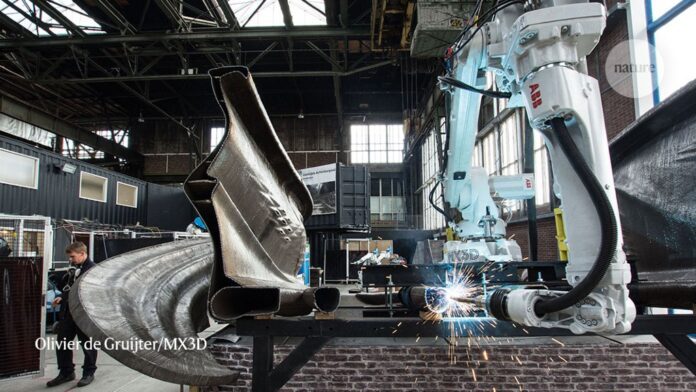
| Perfectly imperfect – that is the technology landscape in metal 3D printing boiled down. On one hand, the diversity in metal additive manufacturing technologies enables complex geometries and opens unique applications that no other manufacturing technique can reach. But these technologies are by no means infallible, and metal AM is ripe for improvement. Through an extensive benchmarking study, IDTechEx has asked the question: where are metal additive manufacturing technologies going, and where are the whitespaces for advancement in the metal AM landscape? In IDTechEx’s report “Metal Additive Manufacturing 2022-2032: Technology and Market Outlook“, fourteen different metal 3D printing technologies were comprehensively analyzed and benchmarked against each other to assess their strengths and shortcomings. Not only does this analysis include established technologies like direct metal laser sintering, blown powder-directed energy deposition, and metal binder jetting, but it also highlights emerging technologies like electrochemical deposition, metal-polymer filament extrusion, and paste extrusion. This article will provide some broader takeaways regarding developments in metal additive manufacturing technologies, but for the full market analysis including technology benchmarking studies and granular market forecasts, see the IDTechEx report. |
| Infographic summarizing the strengths and weaknesses of fourteen metal AM technologies. Source: IDTechEx – “Metal Additive Manufacturing 2022-2032: Technology and Market Outlook“ |
| The Trends Introducing technologies capable of processing cheaper feedstocks:Metal feedstock for 3D printing, specifically uniform metal powder, is a difficult barrier to adoption for metal 3D printing; it is difficult for SMEs to find the budget to purchase kilos of metal powder priced in the hundreds. However, several emerging technologies make a point of utilizing cheaper metal feedstock to reduce the price per part for metal 3D printing. These include two extrusion technologies – metal paste (or metal slurry) and metal pellet extrusion. Paste and pellet extrusion are not the first metal additive technologies on the market to process inexpensive feedstock. That would be wire-directed energy deposition and sand binder jetting. However, where these extrusion technologies succeed while wire DED and sand binder jetting falter is their inexpensive printer price. The combination of inexpensive printers with inexpensive feedstock is a compelling one that lowers 3D printing costs. Pushing the build envelope in both directions: large and smallThe fifteen technologies assessed by IDTechEx had build envelopes covering a very wide range from 0.0004 m³ to 20.75 m³. Where traditional technologies like laser powder bed fusion and electron beam melting had a relatively constrained range of build volumes that limited part sizes, technologies like cold spray and electrochemical deposition enable a far wider range of part sizes. Metal can now be additive manufactured to be as tall as a double-decker bus or as small as a fingertip. With that increased range of possible component sizes comes a greater range of possible applications for metal additive manufacturing to penetrate. The Whitespaces Finding the intersection between build volume and price:In metal additive manufacturing, the relationship between build volume and printer price is crystal clear with an increased build volume comes increased printer costs. In fact, the biggest printers on the market exceed $2-3 million in price. Through large-format complex 3D-printed parts might be compelling in some applications, like construction, the expensive machinery needed makes these applications difficult to pursue. Any new printer that can combine large-format build volume with a price tag under half a million while maintaining key properties like tensile strength and surface finish would find itself unmatched in that whitespace. Balancing build rate with resolution:Build rate (sometimes known as material throughput) and resolution seem like inherently opposed qualities. How can it be possible to build fast when one also needs to print fine details or achieve a smooth surface finish? Current metal printing technologies demonstrate the inverse relationship between throughput and resolution quite clearly. However, finding the balance between high build rate and high resolution might not be as impossible as it seems. For comparison, consider that continuous resin printing techniques such as Carbon’s CLIP (continuous light interface production) and EnvisionTEC’s cDLM (continuous digital light manufacturing) in polymer 3D printing innovated to bring fast printing with high surface quality. With the right technical innovations, this gap might be bridgeable. And if that balance is found, metal additive manufacturing can move closer towards high volume, end-use part production. The Metal Additive Manufacturing Technology Landscape In assessing hundreds of printers segmented into fourteen technology categories, it became evident that the individual technologies in metal AM cover many different strengths, from high resolution to low printer to high materials throughput. When considered as an aggregate, metal AM has enough processes to cover opportunities for value-add in numerous industries like oil/gas, renewable energy, and automotive. As new technologies and innovations continue to expand this landscape and address technical weaknesses, IDTechEx expects to see the possible applications for metal additive manufacturing to continue to expand into an uncharted but high-value territory. Market forecasts for Metal Additive Manufacturing IDTechEx’s report includes extensive technology analysis and benchmarking studies comparing 14 different emerging and established technologies. The report also forecasts future revenue, install base, and materials demand for the metal AM market while carefully segmenting the metal AM technology and materials market by 10 process categories and 9 metal material categories. Additionally, IDTechEx provides detailed discussion on the metal AM materials market. For further information on this market including interview-based profiles of the main players, technology benchmarking studies, application case-studies, and the most granular 10-year market forecasts available, see the market report “Metal Additive Manufacturing 2022-2032: Technology and Market Outlook“. For more information on this report, please visit www.IDTechEx.com/MetalAM, or for the full portfolio of 3D Printing research available from IDTechEx please visit www.IDTechEx.com/Research/3D. |
Help keep news FREE for our readers
Supporting your local community newspaper/online news outlet is crucial now more than ever. If you believe in independent journalism, then consider making a valuable contribution by making a one-time or monthly donation. We operate in rural areas where providing unbiased news can be challenging. Read More About Supporting The West Wales Chronicle
























